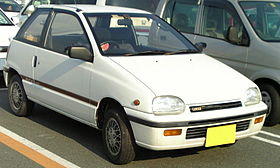Daihatsu Leeza
| Daihatsu Leeza (L100/L111) | |
|---|---|
 | |
| Overview | |
| Manufacturer | Daihatsu |
| Production | 1986–1993 |
| Body and chassis | |
| Class | Kei car |
| Body style | 3-door hatchback 2-door cabriolet |
| Layout | Front-engine, front-wheel-drive |
| Related | Daihatsu Mira |
| Powertrain | |
| Engine | 547 cc EB10/40 I3 (petrol) 547 cc EB20/21/26 I3 (t/c petrol) 659 cc EF-HL I3 (petrol) 659 cc EF-JL I3 (t/c petrol) |
| Transmission | 4/5-speed manual 2/3-speed automatic |
| Dimensions | |
| Wheelbase | 2,140 mm (84.3 in) |
| Length | 3,295 mm (129.7 in) |
| Width | 1,395 mm (54.9 in) |
| Height | 1,335 mm (52.6 in) |
| Curb weight | 640 kg (1,411 lb) |
| Chronology | |
| Successor | Daihatsu Opti Daihatsu Copen (Leeza Spider) |
The Daihatsu Leeza is a kei car with coupé styling which was launched in Japan by Daihatsu in December 1986.[1] It was taken out of production in August 1993 after having been largely replaced by the Daihatsu Opti of 1992. While having coupé lines, most of the Leezas sold in Japan were technically speaking commercial vehicles (with strapping points and temporary rear seats) to take advantage of ample tax breaks for such vehicles.
550 cc versions[]
Power output from the carburetted 550 cc EB-series three-cylinders was originally either 32 or 50 PS, depending on whether a turbocharger was fitted. In late 1987 a limited edition called the ChaCha arrived, aimed at women around the age of 30 and only available in black with discreet red pinstripes, equipped with standard air conditioning.[2] In January 1989 the TR-XX EFi, a fuel injected 64 PS version was added, followed by a Club Sports edition in October which offered a lowered suspension and body kit.[3] At the 1989 Tokyo Motor Show, a prototype two-seat "Leeza Spider" was shown.[2]
While a modern and clean design for its time, and with an airy interior, the sloping rear glasshouse made the rear seat rather cramped indeed. The front seats were spacious, but at the expense of the rear - fitting four adults in the Leeza would not be comfortable for any of them.[4] The 32 PS version (manual, five-speed) went from 0-60 mph in 21.3 seconds in a period British road test, reaching a top speed of 75 mph (121 km/h).[5] "Driven hard" it returned a gas mileage of 41.3 mpg‑imp (6.84 L/100 km; 34.4 mpg‑US), although one could expect much higher with some economising. Suspension, steering, gearing: in short all design parameters of the Leeza were designed with city use in mind, making it not very well suited to highway use.[5]
660 cc update[]
In March 1990, the Kei car regulations changed. Unlike its competitor the Suzuki Cervo, Daihatsu chose to update the Leeza, giving it the new chassis code L111. The new Leeza, arriving a little later than its more popular sibling the Mira, in August 1990, was now available for between ¥698,000 and ¥950,000 in R, ChaCha and OXY trim lines. By now, the ChaCha was a regularly available model rather than a special edition. The larger 50 PS 660 cc engine and slightly enlarged bodywork made for a more usable car, and allowed for the fitment of more safety equipment. However, the tax advantages for faux commercial vehicles had been withdrawn, and the Leeza was now only sold as a passenger car, limiting its market.

Five months after the update, the turbocharged OXY-R (with the maximum 64 PS allowed to kei cars) arrived, with a prominent bonnet vent for the intercooler. Daihatsu also went through the effort of making the two-seater convertible version of the Leeza called the "Spider" ready for production. The Spider received a standard leather interior. There was also a Spider-based show car in 1991, called the FX-228.[6] The Spider (L111SK), only fitted with the turbocharged engine, arrived in November 1991 and lasted until the end of production in August 1993.
References[]
- ^ Kobori, Kazunori (2007). ダイハツ 日本最古の発動機メーカーの変遷 [Daihatsu: The History of Japan's Oldest Engine Company] (in Japanese). Tokyo: Miki Press. p. 75. ISBN 978-4-89522-505-2.
- ^ a b Kießler, Bernd-Wilfried (1992), Daihatsu Automobile: Erfahrung für die Zukunft (in German), Südwest, p. 57, ISBN 9783517012254
- ^ カタログ / ダイハツ リーザ クラブスポーツ(1989年10月) [Catalog: Daihatsu Leeza Club Sports (October 1989)]. Goo-net (in Japanese). Proto Corporation. Retrieved 2012-07-12.
- ^ Buchanan, Nick (1988-06-29). "Mini, meet Leeza". Autocar. 177 (1): 60.
- ^ a b Buchanan 1988, p. 62.
- ^ "1991 Daihatsu FX-228" (in Russian). Car Styling. Retrieved 2012-07-12.
- Cars introduced in 1986
- 1990s cars
- Daihatsu vehicles
- Kei cars